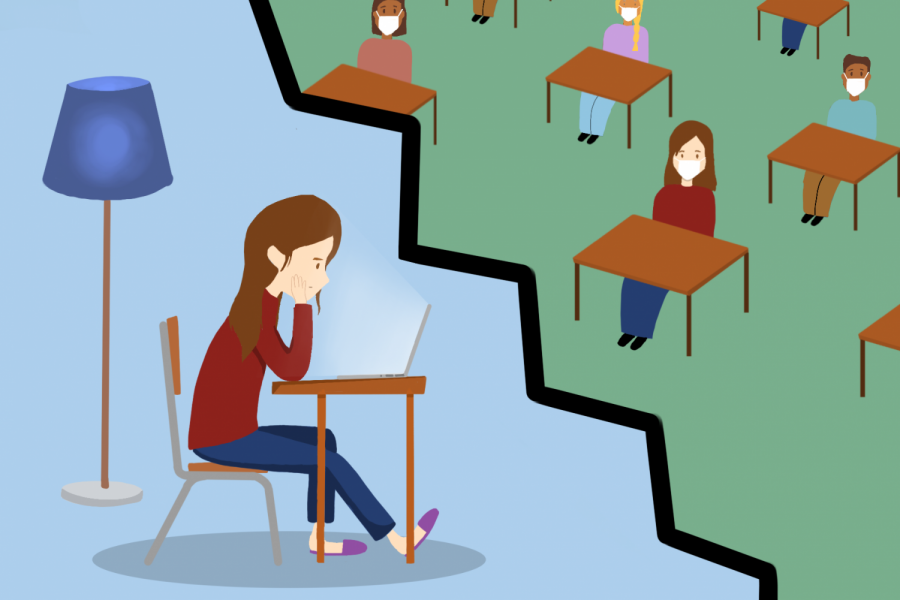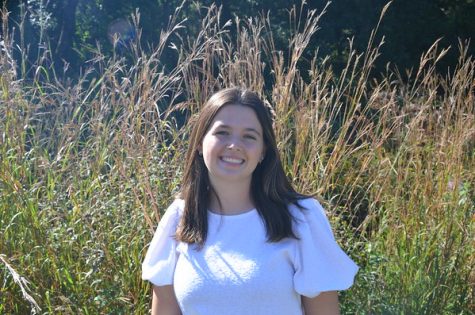WHS students reflect on hybrid learning experience
Credit: Elizabeth Zhong
Three months into hybrid learning, students are learning how to adjust to a new style of schooling. “I think that starting hybrid was confusing like what time class ended and what classes you had because they changed everything from before,” sophomore Morgen Warner said. “I think getting used to that took a little.”
January 29, 2021
A year ago, the thought of doing school at home and being able to sleep in and have a more flexible schedule would have excited many students. But now, the vast majority of students look forward to the days when they get to attend school in person. Beginning on Oct. 19, 2020, students at WHS had to adjust to hybrid learning. Now almost three months later, students can reflect on how this new style of schooling has changed how and what they are learning.
Sophomore Morgen Warner is one of many students who misses going into school everyday, and she believes that when students are on Zoom, they miss a big social aspect that in-person school offers.
“If I could go to school [in person] all the time I would,” Warner said. “Since I can’t, I think it is at least nice to go half the week. [Hybrid learning] is a little weird, but it’s better than sitting at home for a long time.”
Although not all students prefer in person learning to virtual learning, some find it more engaging than remote days. They found learning at home to be too distracting.
“I prefer in school [learning] because for myself, I get distracted very easily when I’m at home and sitting at my desk and I have my phone and other things around me,” Warner said. “I tend to lose focus, but in school, the teacher is watching you and it is much easier to stay engaged during class.”
For some students, however, the setup of the hybrid model can even be ideal as each environment has its own benefits.
“[I like hybrid] because it is a good mix between going into school and staying home, ” sophomore Lila Powers said.
While hybrid does have its perks, the model also has a list of downfalls many students have begun to notice. The most prominent issue that some found is the amount of information they were able to learn in hybrid versus an in-person model.
“I tend to zone out and get bored when I’m learning from home, so I feel like I’m not always learning as much,” Powers said. “I think we are also moving a lot slower so everyone has a chance to be in school. If the class in school is doing something different, then the teacher has to teach it twice so it is moving much slower.”
Another disadvantage comes when students want to ask their teachers questions and participate in class or breakout rooms. They often feel awkward or as if they were interrupting a classmate.
“Sometimes, depending on the class, [either] people talk [or] are just really silent and it gets confusing and awkward,” freshman Isabelle Peredna said.
Students also have noticed that the testing structure has led to more stress, since some teachers give their tests to students regardless of whether they are in person or not. Some students in Cohort B feel like they are at a disadvantage because they feel they often take tests in person when Cohort A takes them from home.
“The kids at home should not be cheating, but there is always a small thing inside your head telling you they are cheating,” Powers said. “My teachers tend to give us quizzes on only Thursdays and Fridays when Cohort B is in school, and I get it because they don’t want to give it at the beginning of the week because you are learning a new subject, and they don’t want you studying over the weekend, but it just makes it much harder for Cohort B.”
With hybrid still in effect, both students and teachers are adjusting to the new normal. Peredna has even found her favorite ways of learning within the hybrid model.
“I think that the [attendance] forms and then going on to Zoom if you have questions is nice because you get to do your own things and then ask questions on one if you have them,” Peredna said.
Over the course of the year, the entire school continues to find ways to make the best of the situation and bring a touch of normalcy back into school life.
“[Hybrid] is a lot better than last year, when we had to be all remote, and at the beginning of the year because I feel like you get to know people in your classes and your teachers,” Warner said.





![Last Wednesday, the Wayland School Committee gathered to discuss a number of topics regarding the health curriculum and Innovation Career Pathway course. Another large topic of conversation was the ways to potentially mitigate distracting cell phone usage. "These [phones] are going to distract your learning and social relationships," Superintendent David Fleishman said. "That's concrete right there."](https://waylandstudentpress.com/wp-content/uploads/2025/06/Screenshot-2025-06-04-at-9.49.31 PM-1200x886.png)



























![Troy Hoyt finishes the Boston Marathon, running for the Hoyt Foundation. T. Hoyt is the son of Hoyt Foundation CEO Russ Hoyt.
“[Running a marathon] might seem like a big thing, when it’s presented to you at first, but if you break it up and just keep telling yourself, “Yes, you can,” you can start chipping away at it. And before you know it, you’ll be running the whole 26 miles, and you won’t even think twice about it.” T. Hoyt said.](https://waylandstudentpress.com/wp-content/uploads/2025/04/C36E8761-1CBB-452E-9DF2-543EF7B1095E_1_105_c.jpeg)














































